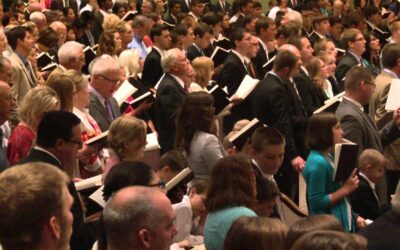The most public ministry of any church is the corporate worship of God. For most congregations the Sunday morning worship service is the “front door” to the church. But that does not mean that the church should plan and implement its worship to focus on worshipers. Quite to the contrary, effective worship doesn’t focus on the worshiper but rather focuses the worshiper on God and gives the worshipers common voice to offer their corporate praise to God. The best practices of traditional worship are built upon hallmarks of an effective order of worship. These hallmarks create the framework by which we design, implement, and evaluate our corporate order of worship. Here are 5 questions to ask to help you design and implement an effective order of worship.
- Does your music match the message? I’ve posted a lengthy blog on this topic here if you’d like a more detailed explanation, but in summary in the best practices of traditional worship the music and the message will match. All the music of the service, the anthems, the hymns, the offertory, the prelude, the postlude, all of it must amplify or summarize the central theme of the service of worship. The theme is derived from the scripture readings and sermon and typically the pastor selects or develops the theme. The musicians then select music that matches or fits that theme. When music and message match all parts of the service point in the same direction creating a unity, a cohesiveness, a wholistic encounter that makes worship come alive and empowers the worshipers in their praise of God.
- Does your service include all 6 core components of traditional worship? I’ve created a free mini course that introduces the 6 core components of traditional worship. Simply scroll to the bottom of this page to sign up! But in summary the 6 core components are Revelation, Adoration, Confession, Expiation, Proclamation, and Dedication. In a service of worship there should be acts of worship that correspond to all 6 components. An act can be singing hymns, prayer, scripture readings, the sermon, the anthem, reciting a statement of faith, responses, the offertory, etc. The best practices of traditional worship will ensure that there are acts of worship that address all six core components. Using the 6 core components as your guide helps you model the content and flow of Biblical worship.
- Does your service include a variety of acts of worship? We humans have short attention spans so we need variety to stay focused. The best practices in traditional worship will vary the acts of worship in both type of acts and distribution of the acts throughout the service. Some acts are passive like listening to the sermon. Some acts are active like standing and singing hymns. Worshipers need as many different active acts as are possible and practical. They need to be active participants, not simply spectators. But these active acts should be peppered throughout the service not lumped in one place. The sermon is a lengthy passive act of worship so it should be surrounded by active acts. Variety is the spice of life and of worship!
- Does your order of worship focus on content? This is an enormous problem in the church today. Well-meaning but misguided worship leaders have equated style with content. They are not the same! Content serves the order of worship. Style serves itself. In the best practices of traditional worship content is king. The goal of the order of worship is to provide the means—the content—for the congregation to engage CORPORATELY in a dialogue between the creator and His creation. Every act of worship you incorporate into your order of worship must tie directly to this dialogue and point to God, not to itself, and certainly not to us. Content enables. Style divides. Focus on content.
- Does your order of worship point to God? Far too often our worship points to something else, our emotions for example. This self-centered design of worship places us as the objects of worship. God tells us that we are to have no other gods before Him. The best practices of traditional worship will plan and implement an order of worship that focuses on God, that points to Him as the only object of our worship and gives the congregation the corporate tools to do so. In many instances we try to use worship for other purposes. Sometimes these are very good and important things like evangelism or fellowship, but other times they are anathema to worship like politics or the elevation of the self. Worship is for God. Point to God in your worship and everything else will take care of itself.
No doubt you have ideas to add to the discussion! What are some of your hallmarks of an effective order of worship? Post them in the comment section below. We’ll compile your response and discuss them in a future blog.
_______________
Sacred Song Consulting exists solely to help congregations refine, revitalize, and reform traditional worship for contemporary people. We are a resource for all worship leaders. We are a guide to lead you to the best practices of traditional worship. We provide you with the tools to plan, prepare, and lead traditional worship, the nuts-and-bolts concepts, the practical ideas that help traditional worship honor God and enrich the congregation. We are here to help you! You are not alone in your desire to have transformative worship in your congregation. Reach out to us. Let us know how we can help!



0 Comments